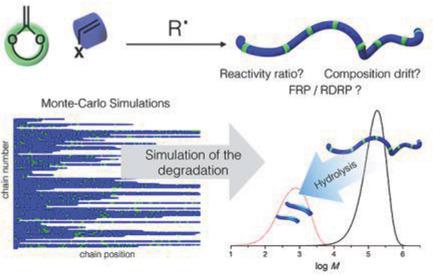当前位置:
X-MOL 学术
›
Macromol. Rapid Commun.
›
论文详情
Our official English website, www.x-mol.net, welcomes your
feedback! (Note: you will need to create a separate account there.)
Simulation of the Degradation of Cyclic Ketene Acetal and Vinyl‐Based Copolymers Synthesized via a Radical Process: Influence of the Reactivity Ratios on the Degradability Properties
Macromolecular Rapid Communications ( IF 4.2 ) Pub Date : 2018-05-22 , DOI: 10.1002/marc.201800193 Didier Gigmes 1 , Paul H. M. Van Steenberge 2 , Didier Siri 1 , Dagmar R. D'hooge 2, 3 , Yohann Guillaneuf 1 , Catherine Lefay 1
Macromolecular Rapid Communications ( IF 4.2 ) Pub Date : 2018-05-22 , DOI: 10.1002/marc.201800193 Didier Gigmes 1 , Paul H. M. Van Steenberge 2 , Didier Siri 1 , Dagmar R. D'hooge 2, 3 , Yohann Guillaneuf 1 , Catherine Lefay 1
Affiliation

|
The radical copolymerization of vinyl and cyclic ketene acetal (CKA) monomers is a promising way to prepare degradable vinyl polymers. The reactivity of the comonomer pair is known to be dependent of the vinyl monomer structure that requires to play with experimental conditions (feed ratio, overall monomer conversion, etc.) to target a desired cumulative (average) copolymer composition. Even if the materials are completely degradable, there is no information about the homogeneity of the degraded products. This theoretical study, using kinetic Monte Carlo simulations, allows simulating degradation at the molecular level. It is shown that disparate reactivity ratios (styrene/CKA, etc.) and also a composition drift at high conversion can lead to an inhomogeneous degraded product compared to systems with similar reactivity ratios (vinyl ether/CKA, etc.). The use of reversible deactivation radical polymerization techniques does not influence the final degraded products and is only useful for the design of advanced macromolecular architectures before degradation.
中文翻译:

通过自由基过程合成的环乙烯醛缩醛和乙烯基共聚物的降解模拟:反应率对降解性能的影响
乙烯基和环状乙烯酮缩醛(CKA)单体的自由基共聚是制备可降解乙烯基聚合物的一种有前途的方法。已知共聚单体对的反应性取决于乙烯基单体结构,该乙烯基单体结构需要在实验条件(进料比,总单体转化率等)下发挥作用,以靶向所需的累积(平均)共聚物组成。即使材料是完全可降解的,也没有关于降解产物均质性的信息。这项理论研究使用动力学蒙特卡洛模拟,可以在分子水平上模拟降解。结果表明,与具有相似反应率(乙烯基醚/ CKA等)的体系相比,不同的反应率(苯乙烯/ CKA等)以及高转化率下的组分漂移会导致不均匀的降解产物。)。可逆的减活自由基聚合技术的使用不会影响最终的降解产物,并且仅对降解前先进的高分子结构的设计有用。
更新日期:2018-05-22
中文翻译:

通过自由基过程合成的环乙烯醛缩醛和乙烯基共聚物的降解模拟:反应率对降解性能的影响
乙烯基和环状乙烯酮缩醛(CKA)单体的自由基共聚是制备可降解乙烯基聚合物的一种有前途的方法。已知共聚单体对的反应性取决于乙烯基单体结构,该乙烯基单体结构需要在实验条件(进料比,总单体转化率等)下发挥作用,以靶向所需的累积(平均)共聚物组成。即使材料是完全可降解的,也没有关于降解产物均质性的信息。这项理论研究使用动力学蒙特卡洛模拟,可以在分子水平上模拟降解。结果表明,与具有相似反应率(乙烯基醚/ CKA等)的体系相比,不同的反应率(苯乙烯/ CKA等)以及高转化率下的组分漂移会导致不均匀的降解产物。)。可逆的减活自由基聚合技术的使用不会影响最终的降解产物,并且仅对降解前先进的高分子结构的设计有用。











































 京公网安备 11010802027423号
京公网安备 11010802027423号